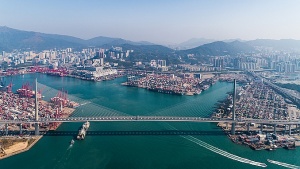The rejuvenation of logistics
There are as many as 17 different types of logistics services in Vietnam. For instance, loading and unloading services, mainly focusing on seaports and inland container deports (ICDs). Many ports have developed forcefully in recent times with professionally developed technology systems, highly automated information systems, and terminal operating systems at about 80 per cent of functions at major ports.
 |
| Tran Chi Dung, member of the Executive Committee at the Vietnam Logistics Business Association |
However, loading and unloading equipment is still running semi-automatically and manually on command, especially at small ports and ICDs. The next challenge is applications to improve the performance of each port and especially the connection among ports, between ports and shipping lines and other transporters such as barges, roads and railways, creating an integrated service chain.
For container warehousing services, including large container yards at ports, logistics centres and ICDs, in general, all have been digitalised and applied management systems. However, the level of modernity of the systems is very different, leading to unevenness between advanced systems in large ports which are almost automatic and small container yards managed manually.
Sea freight transport services are provided by large and professional shipping lines, which have global management systems. Currently, the trend of cutting out intermediaries is very popular. Shipping lines are gradually moving to automate the distribution and sale of freight, and integrate services throughout the supply chain.
They are trying to transform themselves into a supply chain management company, and they have the conditions to realise this ambition due to high profits over the past few years. This situation puts great pressure on Vietnamese shipping companies, which have just escaped from a domestic crisis and are still small in scale. The selection of technology among Vietnamese shipping companies will depend greatly on their business model and development goals.
Inland waterway freight transport services are provided by inland transport companies, and some of which have become professional. They already have basic transport management technologies, but the connection with other systems is low.
Railway freight transport services are very limited, provided by a few domestic transport service companies, with very outdated technology and equipment. This has been a problem for many years.
Catching up
In terms of road freight transport services, they are provided by domestic transport companies, with the majority being truck companies, transport cooperatives, and personal vehicles. Among them, some have been organised and managed professionally. In addition to mandatory equipment and systems such as GPS, basic transportation management systems are not yet popular, while this group of services accounts for up to 75 per cent of total shipping volume.
Air cargo transport services are provided by domestic and foreign air carriers operating in Vietnam. The technology applied by these carriers is of high standards because they must always comply with international practices. Like shipping lines, the trend of cutting out intermediaries is currently very popular, and airlines are gradually moving to automate the distribution and sale of freight.
Common platforms that support freight booking are actively opening the Vietnamese market with very dynamic services. Meanwhile, Vietnam still does not have an airline specialising in cargo.
Multimodal transportation services are involved by physical carriers, or Non-Vessel Operating Common Carrier. As this model has been developing for a long, technology and international freight forwarding management system are no longer strange to professional suppliers. Many service providers are using this technology. However, Vietnam does not have many service providers using world-standard technology systems, often due to cost.
In ASEAN, most nations are far behind Singapore in digital transformation of logistics. Vietnam’s level of applied tech is not far from Malaysia and Thailand. And we are confident of being dynamic in working with our Indonesian and Philippine colleagues.
The effectiveness of technology application at large companies is currently good. For example, Saigon New Port, after successfully applying advanced production management and operation programmes, has reduced the time of ships staying at dock by 55 per cent, reducing goods delivery time three-fold, cutting 60 per cent of labour and traffic incidents.
The ePort electronic port product is one of the successful projects, helping reduce the time for vehicles to wait at the port gate from 13 minutes to around half of that. And the electronic customs clearance time has been reduced by two minutes per container, which helps increase gate delivery output from 11,000 up to 20,000 vehicles a day.
Similarly, Vietnam Post is building the Vmap platform and a real-time address database on positioning, address data, and assigning codes to addresses to households. The platform can digitalise and accurately locate customers’ addresses to provide information for businesses in industries, sectors, and services that need to find customers.
Nevertheless, many businesses providing logistics services are small- and medium-sized enterprises (SMEs) with weak financial resources. On average, the process of digital transformation for an entire enterprise can reach millions of US dollars, which SMEs cannot afford. If businesses decide to invest in automation like foreign models, initial investment is costly. If they follow the internal model, it will cost IT human resources and take a lot of time. In addition, it is also difficult for them to find suitable solutions due to limited knowledge and information about solutions.
It will be extremely difficult for logistics service providers to do digital transformation without support for research and development and technology investment from the state or financial and credit institutions.
There are also the limitations of solution providers, including schools and institutes. We are renowned for being good at IT, and have many engineers, masters, PhDs, technology corporations, and others, but in reality there are too few convincing solution providers. The biggest limitation is that most companies only provide single solutions, and are not yet connected into a digital platform for the national logistics service industry.
Aspects for development
Our surveys indicate that digital transformation in the logistics industry is facing many difficulties, such as lack of connectivity, lack of information about digital tech, lack of related infrastructure, lack of internal human resources, and difficulties in investment costs and application, as well as struggles in changing habits and business practices.
In addition, more than 90 per cent of SMEs have difficulties choosing technology suitable for their services.
To promote digital transformation in logistics, four factors should be in focus, and the first is policy and mechanisms. Vietnam has many policies, resolutions, and programmes, but most of them are on paper, and the effectiveness of implementation is very limited. There should be more policies to solve these existing problems. It is particularly necessary to have development policy mechanisms to accompany and connect with global digital supply chains, with more creative and sustainable economic models.
Second is infrastructure to support digital transformation. In parallel with integrated planning, it is necessary to review and build important new infrastructure development projects such as shared data warehouses, digital maps, and logistics information infrastructure, and related supply chain applications. We must also develop technical infrastructure to support green transportation, energy transition, fuel usage and support the development of application platforms in trade, transportation, and finance, and especially in integrating all three groups, called Buy-Ship-Pay model.
Third is digital transformation for service providers. We must develop information infrastructure investors, providing a variety of services to support logistics service providers, helping them become professional regardless of the model they operate.
The final aspect is the overhaul of logistics at service user groups. It is necessary to have applications in purchasing, manufacturing, warehouse and reserve management, distribution management, delivery, customers’ services, and applications in industries and all sizes of businesses.
 | Logistics providers in Hong Kong eye Vietnamese market Logistics service providers from Hong Kong are looking to strengthen partnerships with their Vietnamese counterparts to tap into the nation's logistics market. |
 | Promoting vocational education in logistics Vietnam has numerous opportunities to drive the development of the logistics industry, yet it still faces a shortage of professionally trained personnel. |
What the stars mean:
★ Poor ★ ★ Promising ★★★ Good ★★★★ Very good ★★★★★ Exceptional
Related Contents
Latest News
More News
- Main drivers for Vietnam’s digital economy future (December 03, 2025 | 11:35)
- Pivotal stage of growth paves way for rise in M&As (December 03, 2025 | 10:00)
- Positive projections for M&A interest from Thailand (December 03, 2025 | 09:40)
- Manifesting the first line of defence in cybersecurity (December 03, 2025 | 09:00)
- The transformational role AI can play in accounting arena (December 03, 2025 | 08:00)
- Unlocking 5G-AI potential in Singapore (December 03, 2025 | 08:00)
- Data-driven strategies vital for a fast-evolving nation (December 02, 2025 | 09:41)
- Policy to practice: how Vietnam can lead the region (November 26, 2025 | 16:03)
- Mobilising private capital at scale vital for climate battle (November 26, 2025 | 15:36)
- VILAF and Yoon & Yang launch Vietnam - Korea Practice Unit (November 26, 2025 | 15:16)

 Tag:
Tag:





















 Mobile Version
Mobile Version